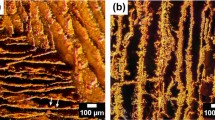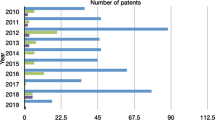Abstract
Understanding the evaporation of a multi-component droplet has found immense importance in various technological applications. This study investigates the evaporation behaviour of a colloidal binary droplet system comprising of the ethanol-water mixture and polystyrene nanoparticles. The wetting and evaporation dynamics were studied with an emphasis on the collective influence of ethanol and nanoparticle concentrations. The temporal behaviour of the contact angles, shapes and volumes of the droplets was monitored in order to analyse the evaporative behaviour. With increase of ethanol concentrations, the binary droplet volumes were found to decrease nonlinearly with time. Ethanol being more volatile evaporated in the initial stage. Towards the end of the evaporation process, the evaporation characteristics mimics the behaviour of pure water. Our study shows that the initial contact angle decreases monotonically with increased concentration of ethanol in the mixture. The contact angle is maximum for a particular nanoparticle concentration. Droplets with higher ethanol concentration show higher wettability which in its turn is maximum for low nanoparticle concentrations. This trend shows the interconnected effect of ethanol and nanoparticle concentrations on evaporation. Rim width of the final deposition pattern increases with nanoparticle concentration although it is almost independent of ethanol concentration. Finally, it is noticed that fast evaporation of a relatively more volatile component in a binary mixture droplet leads to nanoparticle segregation for low nanoparticle concentrations. Thus for binary mixtures, the evaporation of the more volatile component, ethanol for our case, offers characteristic differences in the resulting evaporation dynamics from that of pure water which finds applicability for multi-component evaporation processes.
Graphic abstract










Similar content being viewed by others
References
A. Shimoni, A. Azoubel, A. Magdassi, Inkjet printing of flexible high-performance carbon nanotube transparent conductive films by coffee ring effect. Nanoscale 6, 11084–11089 (2014)
B. Sobac, D. Brutin, Desiccation of a sessile drop of blood: cracks, folds formation and delamination. Colloids Surf. A Physicochem. Eng. Asp. 448, 34–44 (2014)
V. Lazarus, L. Pauchard, From craquelures to spiral crack patterns: influence of layer thickness on the crack patterns induced by desiccation. Soft Matter 7, 2552–2559 (2011)
M.A. Winnik, Latex film formation. Curr. Opin. Colloid Interface Sci. 2, 192–199 (1997)
S. Choi, S. Stassi, A.P. Pisano, T.I. Zohdi, Coffee-ring effect-based three dimensional patterning of micro/nanoparticle assembly with a single droplet. Langmuir 26(14), 11690–11698 (2010)
L. Chen, J.R.G. Evans, Drying of colloidal droplets on superhydrophobic surfaces. J. Colloid Interface Sci. 351(1), 283–287 (2010)
D. Lohani, S. Sarkar, Nanoscale topographical fluctuations: a key factor for evaporative colloidal self-assembly. Langmuir 34(43), 12751–12758 (2018)
Y. Li, C. Lv, Z. Li, D. Quere, Q. Zheng, From coffee rings to coffee eyes. Soft Matter 11, 4669–4673 (2015)
M. Parsa, S. Harmand, K. Sefiane, M. Bigerelle, R. Deltombe, Effect of substrate temperature on pattern formation of nanoparticles from volatile drops. Langmuir 31(11), 3354–3367 (2015)
D. Brutin, Influence of relative humidity and nano-particle concentration on pattern formation and evaporation rate of pinned drying drops of nanofluids. Colloids Surf. A Physicochem. Eng. Asp. 429, 112–120 (2013)
R.D. Deegan, O. Baka**, T.F. Dupont, G. Huber, S.R. Nagel, T.A. Witten, Capillary flow as the cause of ring stains from dried liquid drops. Nature 389, 827–829 (1997)
S.M. Rowan, M.I. Newton, F.W. Driewer, G. McHale, Evaporation of microdroplets of azeotropic liquids. J. Phys. Chem. B 104(34), 8217–8220 (2000)
K. Sefiane, S. David, M.E.R. Shanahan, Wetting and evaporation of binary mixture drops. J. Phys. Chem. B 112(36), 11317–11323 (2008)
K. Sefiane, L. Tadrist, M. Douglas, Experimental study of evaporating waterâethanol mixture sessile drop: influence of concentration. Int. J. Heat Mass Trans. 46(23), 4527–4534 (2003)
A.K.H. Cheng, D.M. Soolaman, H.-Z. Yu, Evaporation of microdroplets of ethanol-water mixtures on gold surfaces modified with self-assembled monolayers. J. Phys. Chem. B 110(23), 11267–11271 (2006)
J.R.E Christy, Y. Hamamoto, K. Sefiane, Flow transition within an evaporating binary mixture sessile drop. Phys. Rev. Lett. 106, 205701 (2011)
T. Ozturk, H. Yildirim Erbil, Evaporation of water-ethanol binary sessile drop on fluoropolymer surfaces: influence of relative humidity. Colloids Surf. A Physicochem. Eng. Asp. 553, 327–336 (2018)
P. Chen, S. Harmand, S. Ouenzerfi, J. Schiffler, Marangoni flow induced evaporation enhancement on binary sessile drops. J. Phys. Chem. B 121(23), 5824–5834 (2017)
Q. Xu, L. Zhou, X. Du, Y. Yang, Thin film profile and interfacial temperature distribution of binary fluid sessile droplet evaporating on heated substrate. Int. J. Heat Mass Trans. 135, 274–283 (2019)
L. Zhou, Y. Yang, X. Du, Y. Yang, Effect of sessile binary droplet evaporation at different ambient temperatures on interfacial profile near the triple line. Exp. Therm. Fluid Sci. 103, 108–117 (2019)
L. Zhou, Y. Yang, X. Du, Y. Yang, Internal flow near the triple line in sessile droplets of binary mixtures during evaporation at different ambient temperatures. Int. J. Heat Mass Trans. 136, 581–590 (2019)
Y.S. Yu, L. Sun, X. Huang, J.Z. Zhou, Evaporation of ethanol/water mixture droplets on a pillar-like pdms surface. Colloids Surf. A Physicochem. Eng. Asp. 574, 215–220 (2019)
X. Zhong, F. Duan, Evaporation of sessile droplets affected by graphite nanoparticles and binary base fluids. J. Phys. Chem. B 118(47), 13636–13645 (2014)
X. Zhong, F. Duan, Flow regime and deposition pattern of evaporating binary mixture droplet suspended with particles. Eur. Phys. J. E 39(2), 18 (2016)
J. Shi, L. Yang, C.D. Bain, Drying of ethanol/water droplets containing silica nanoparticles. ACS Appl. Mater. Interfaces 11(5), 14275–14285 (2019)
L. Shi, P. Shen, D. Zhang, Q. Lin, Q. Jiang, Wetting and evaporation behaviors of water ethanol sessile drops on ptfe surfaces. Surf. Interface Anal. 41(12–13), 951–955 (2009)
S.H. Behrens, D.G. Grier, The charge of glass and silica surfaces. J. Chem. Phys. 115(14), 6716–6721 (2001)
S. Vafaei, T. Borca-Tasciuc, M.Z. Podowski, A. Purkayastha, G. Ramanath, P.M. Ajayan, Effect of nanoparticles on sessile droplet contact angle. Nanotechnology 17(10), 2523–2527 (2006)
K.B. Singh, M.S. Tirumkudulu, Cracking in drying colloidal films. Phys. Rev. Lett. 98, 218302 (2007)
J. McQuade, L.T. Vuong, Solvent retention and crack evolution in dropcast pedot:pss and dependence on surface wetting. ACS Omega 3(4), 3868–3873 (2018)
Acknowledgements
The authors gratefully acknowledge support by Indian Institute of Technology Ropar. The authors declare no competing financial interest.
Author information
Authors and Affiliations
Contributions
DL and SS conceived and planned the experiments. DL and V carried out the experiments and analysed the data. SS supervised and guided the entire work. All the authors provided critical feedback in interpreting the results, helped shape the research and contributed towards the final version of the manuscript.
Corresponding author
Supplementary Information
Below is the link to the electronic supplementary material.
Rights and permissions
About this article
Cite this article
Versha, Lohani, D. & Sarkar, S. Interconnected drying phenomena in nanoparticle laden water-ethanol binary droplets. Eur. Phys. J. E 44, 35 (2021). https://doi.org/10.1140/epje/s10189-021-00045-6
Received:
Accepted:
Published:
DOI: https://doi.org/10.1140/epje/s10189-021-00045-6




